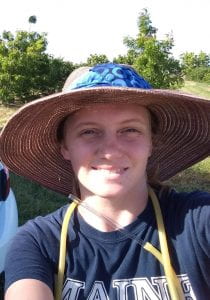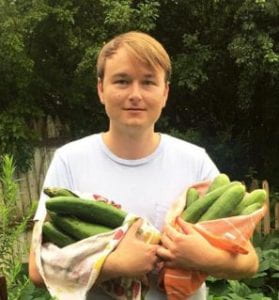-Magdalen Lindeberg
Cyanide transporters in cassva, population analysis of soil bacteria, genetics of drought tolerance in apple – these are a few of the diverse graduate student projects recently funded through the Schmittau-Novak Small Grants Program. Supported by a bequest from the estate of Jean Schmittau in honor of Joseph Novak, Plant Biology Professor Emeritus, the Schmittau-Novak Small Grants Program is designed to provide graduate students in the School of Integrative Plant Science with the opportunity to experience the process of writing and reviewing proposals, and implementing a research plan of their own design. Ten proposals were selected for Spring 2020 funding. The program is directed by Dan Buckley and Teresa Pawlowska.
Molecular Diversity Controls on Dissolved Organic Matter Cycling
Rachelle LaCroix is a PhD student, advised by Johannes Lehmann, in the Soil and Crop Sciences Section. Her research is broadly focused on investigating mechanisms governing soil carbon persistence—an area of study that she became passionate about while studying soil carbon cycles of small, seasonally flooded, wetlands during her prior master’s program at UMass Amherst.
is a PhD student, advised by Johannes Lehmann, in the Soil and Crop Sciences Section. Her research is broadly focused on investigating mechanisms governing soil carbon persistence—an area of study that she became passionate about while studying soil carbon cycles of small, seasonally flooded, wetlands during her prior master’s program at UMass Amherst.
Project: Soil contains more carbon than the biosphere and atmosphere combined. This large pool of C is vulnerable to microbial degradation, resulting in the release of two potent greenhouse gases, methane and carbon dioxide. Carbon-rich organic matter also stores nutrients, mediates the storage and release of inorganic contaminants, and supports ecosystem and microorganism biodiversity. My overarching hypothesis is that the molecular diversity of the organic compounds that compose soil organic matter has direct consequences for its ability to be mineralized by microbes, where higher molecular diversity negatively impacts microbial mineralization rates by imposing numerous restraints on microbial activity. My primary objective is to utilize high-resolution LC-MS to quantify molecular diversity of soil organic matter to develop molecular diversity gradients used in mineralization incubations. This method will enable me to identify how various levels of molecular diversity influence soil carbon mineralization, ultimately aiding our understanding of soil carbon persistence in terrestrial ecosystems.
Functional Characterization of a Putative Cyanide Transporter in Cassava for the Development of Diagnostic Toolkit for Targeted Cassava Breeding

 Alex Ogbonna is a PhD student in the field of plant breeding and genetics in the lab of Dr. Lukas Mueller. His current research is focused on impact of modern breeding on key traits architecture evolution through domestication and its implication for cassava breeding approach. Srinivasan Krishnan is currently working as a Postdoctoral Associate at Boyce Thompson Institute, in the lab of Miguel A. Piñeros. His research interest is to study the structure-function relationship of membrane transport proteins related to human disease and of agronomic value.
Alex Ogbonna is a PhD student in the field of plant breeding and genetics in the lab of Dr. Lukas Mueller. His current research is focused on impact of modern breeding on key traits architecture evolution through domestication and its implication for cassava breeding approach. Srinivasan Krishnan is currently working as a Postdoctoral Associate at Boyce Thompson Institute, in the lab of Miguel A. Piñeros. His research interest is to study the structure-function relationship of membrane transport proteins related to human disease and of agronomic value.
Project: Cassava (Manihot esculenta Crantz), a staple security, is well-adapted for growth in semi-arid climates and has been a traditional crop for subsistence farmers in Sub-Saharan Africa. Major agronomic challenges for cassava consumption include presence of toxic secondary metabolite-compounds, such as the cyanogenic glucosides. As a result of poor cassava processing practice, more than half-a-million cases of cyanide poisoning have been reported in the region and in extreme cases leads to the development of a deadly neurological disease. A robust toolkit to test and identify “low-cyanide” cassava lines is currently unavailable. Hence, we performed Genome Wide Association Study (GWAS) on germplasm from Africa and Brazil, which led to the identification of a gene locus that shows promise in identifying low-cyanide content cassava lines. To understand the role of this in cyanide regulation and to validate our GWAS finding, we will isolate and functionally characterize the gene. The results from this project will propel the development of a diagnostic toolkit that will be useful for cassava breeders to characterize cassava lines based on genetic markers and do targeted breeding.
Phytochemical diversity in defense against insect herbivores
 Gordon Younkin is a PhD student in Plant Biology advised by Georg Jander and interested in the function and evolution of plant specialized metabolism. His research focuses on cardiac glycoside biosynthesis in the crucifer genus Erysimum, one of 12 plant lineages to produce this medicinally and ecologically relevant class of compounds. With this award, he will be working with an undergraduate Plant Sciences student to better understand the biosynthesis and diversity of cardiac glycosides within the genus. Goals of this project include (i) structural determination of unknown Erysimum cardiac glycosides and (ii) understanding how small structural modifications to cardiac glycosides alter uptake, toxicity, or affinity for specific cellular targets.
Gordon Younkin is a PhD student in Plant Biology advised by Georg Jander and interested in the function and evolution of plant specialized metabolism. His research focuses on cardiac glycoside biosynthesis in the crucifer genus Erysimum, one of 12 plant lineages to produce this medicinally and ecologically relevant class of compounds. With this award, he will be working with an undergraduate Plant Sciences student to better understand the biosynthesis and diversity of cardiac glycosides within the genus. Goals of this project include (i) structural determination of unknown Erysimum cardiac glycosides and (ii) understanding how small structural modifications to cardiac glycosides alter uptake, toxicity, or affinity for specific cellular targets.
The Impact of Spatial Scales and Barriers on Streptomyces Bacterial Populations
 Janani Hariharan is a PhD student in Soil and Crop Sciences with Dan Buckley. The proposed research aims to broaden our understanding of microbial biogeography and phylogenetics using the soil-dwelling bacterial genus Streptomyces. Many of the rules governing bacterial biogeography in the soil are still unclear, especially those related to dispersal and bacterial population dynamics across changing environments. The objectives of this proposal are to: (a) identify the impact of geographical distance and barriers on genetic diversity and dispersal patterns in Streptomyces populations across the USA, and (b) identify patterns of horizontal gene transfer in Streptomyces genomes, especially those affected by spatial variables. This funding will also enable an undergraduate student to be trained and mentored in microbiology and genomics.
Janani Hariharan is a PhD student in Soil and Crop Sciences with Dan Buckley. The proposed research aims to broaden our understanding of microbial biogeography and phylogenetics using the soil-dwelling bacterial genus Streptomyces. Many of the rules governing bacterial biogeography in the soil are still unclear, especially those related to dispersal and bacterial population dynamics across changing environments. The objectives of this proposal are to: (a) identify the impact of geographical distance and barriers on genetic diversity and dispersal patterns in Streptomyces populations across the USA, and (b) identify patterns of horizontal gene transfer in Streptomyces genomes, especially those affected by spatial variables. This funding will also enable an undergraduate student to be trained and mentored in microbiology and genomics.
Characterization of Drought Tolerance in Malus prunifolia [(Willd.) Borkh] and Genetic Mapping of Fire Blight Resistance in a Bi-parental Population


 Andrew Scheldorf is a PhD student in Horticulture in the program of Susan Brown. Co-PI Brandon Miller is also a graduate student in Horticulture. Co-PI Richard Tegtmeier is a graduate student in Plant Breeding & genetics working in the program of Awais Khan.
Andrew Scheldorf is a PhD student in Horticulture in the program of Susan Brown. Co-PI Brandon Miller is also a graduate student in Horticulture. Co-PI Richard Tegtmeier is a graduate student in Plant Breeding & genetics working in the program of Awais Khan.
Project: Malus prunifolia [(Willd.) Borkh] is a taxon of horticultural interest due to its resistance to the fungal pathogen of apple scab [Venturia inaequalis (Cooke)G)], bacterial pathogen fire blight [Erwinia amylovora (Burrill)] and claims of drought tolerance. Few studies have accurately characterized physiological drought tolerance in Malus. Drought tolerance in M. prunifolia will be investigated using a Vapor Pressure Osmometer (VPO). This technique will not only provide a screening tool for novel crosses, but will also provide experimental evidence to support or refute claims of drought tolerance in M. prunifolia. Similar to the claims of drought tolerance, analysis of fire blight resistance in Malus prunifolia has yet to be a priority of study and explored on a deeper genetic level. Recent research has provided evidence that root vigor traits-possibly associated with drought avoidance mechanisms-are tied to fire blight resistance. If drought avoidance traits convey disease resistance, then it is likely that drought tolerance will as well, thus elucidating a key relationship for directing plant breeding of apples.
Investigating the Unique Carbon Concentrating Mechanism of Hornworts
 Tanner Robison is a first year PhD Student in Fay-Wei Li’s lab. He did my bachelor’s and master’s degree at Utah State University where he worked on a variety of projects, ranging from plant physiology to bioinformatics. In his spare time, he enjoys gardening, riding bicycles, and reading.
Tanner Robison is a first year PhD Student in Fay-Wei Li’s lab. He did my bachelor’s and master’s degree at Utah State University where he worked on a variety of projects, ranging from plant physiology to bioinformatics. In his spare time, he enjoys gardening, riding bicycles, and reading.
Project: Certain organisms have evolved biophysical carbon-concentrating mechanisms (CCM) in order to reduce photorespiration. The green alga Chlamydomonas reinhardtii has been traditionally the model to study biophysical CCM with the hope to install a similar mechanism into crops. On the other hand, hornworts, a lineage of bryophytes, are the only land plants having a biophysical CCM similar to Chlamydomonas. Owing to their much closer relationship to crop plants, lessons learned from hornworts might have a higher translational potential than that of Chlamydomonas. With this grant, we intend to explore the photosynthetic capabilities of multiple hornwort species to better understand the diversity of this adaptation among hornworts. Additionally, we will use RNA-seq on a selection of hornwort species which display inducibility in their CCM to screen for genes essential to CCM function.
Connecting soil conservation research with farmers: Horizontal knowledge sharing as a method for increased soil health practice adoption in New York State
 Jenny Berkowitz in a PhD student in Horticulture with Thomas Bjorkman
Jenny Berkowitz in a PhD student in Horticulture with Thomas Bjorkman
Project: Soil health conservation practices, such as cover cropping, organic nutrient amendments and microbial inoculants are an essential practice that could help respond to food and environmental crises. Soil health practice adoption remains low amongst farmers around the United States and is not well represented in USDA research funding. Developing countries have successfully enacted movements that utilize farmer to farmer knowledge transfer systems such as La Via Campesina. A group that utilizes horizontal knowledge sharing in the U.S. is the American Farmland Trust Soil Health Specialist Training. During this project, I will observe their focus groups and conduct in depth individual interviews assessing the influence of culture, values, infrastructure, government policies and the farmers themselves in order to identify interactions between decades of past social research on sustainable motivation. By qualitatively analyzing the horizontal knowledge sharing system in the U.S., I will be able to identify detailed, localized interactions between these theories, hopefully informing extension and outreach efforts for increasing the adoption of soil health practices.
Using genome-wide association mapping to identify loci regulating vector competency in Diaphorina citri, insect vector of citrus greening disease
M arina Mann is starting her 3rd year as a Plant Pathology and Plant-Microbe Biology PhD in Michelle Heck’s vector biology lab, located in the Boyce Thompson Institute. Her research focuses on vector-pathogen-host interactions, using citrus greening disease as her pathosystem. Her thesis work leverages the natural diversity of vector populations to study the quantitative phenotype of variable pathogen transmission. In her free time, she is a long distance cyclist and enjoys trying new restaurants – Ithaca has so many!
arina Mann is starting her 3rd year as a Plant Pathology and Plant-Microbe Biology PhD in Michelle Heck’s vector biology lab, located in the Boyce Thompson Institute. Her research focuses on vector-pathogen-host interactions, using citrus greening disease as her pathosystem. Her thesis work leverages the natural diversity of vector populations to study the quantitative phenotype of variable pathogen transmission. In her free time, she is a long distance cyclist and enjoys trying new restaurants – Ithaca has so many!
Project: Citrus greening disease, also known as Huanglongbing (HLB), is considered the most serious disease of citrus. Controlling transmission of the bacterial pathogen, “Candidatus Liberibacter asiaticus” (CLas) by the hemipteran insect vector (Diaphorina citri), represents a promising new avenue for stopping the rapid spread of HLB among healthy citrus groves. In all D. citri populations, naturally occurring, non-vector individuals make up a significant proportion of individuals in a population. Previous studies have shown that the ratio of vectors to non-vectors in a population is heritable, suggesting the ability to transmit is genetically linked. This proposal aims to identify the genetic differences between vector and non-vector D. citri individuals using genome wide association studies (GWAS) on wild populations of D. citri.
Establishing the role of CITFL1 transcription factor in copper homeostasis and reproduction of Brachypodium distachyon

 Tetiana Zavodna is a graduate student in Soil & Crop Sciences in the program of Olena Vatamaniuk. Elizabeth Mahood is a graduate student with Gaurav Moghe in Plant Biology
Tetiana Zavodna is a graduate student in Soil & Crop Sciences in the program of Olena Vatamaniuk. Elizabeth Mahood is a graduate student with Gaurav Moghe in Plant Biology
Project: Copper (Cu) is a micronutrient that is important for the growth, development, and fertility of plants. However, Cu can be toxic if it is accumulated in high concentrations. SPL7 (SQUAMOSA promoter binding protein–like7) is a major regulator of Cu uptake and homeostasis in the model dicot A. thaliana. Additionally, it was discovered that a previously uncharacterized member of the basic-helix-loop-helix (bHLH) transcription factor family, CITF1 (Cu- induced transcription factor 1) interacts with SPL7, is essential for the normal growth of A. thaliana under Cu deficiency, and regulates Cu uptake into roots and delivery to flowers. However, how Cu uptake and transport processes are regulated in grasses including wheat and rice, is not well known. This proposal focuses on the role of CITF1 in copper homeostasis and fertility in the model grass Brachypodium through analyses of differentially expressed genes between Wild Type and Bdcitfl1 mutant plants.
The relative importance of biotic and abiotic processes for understanding the dynamics of glyphosate herbicide in soils

 Behrooz Azimzadeh is a PhD candidate in Soil and Crop Sciences with C. Enid Martínez, studying the fate of agrochemicals at the organo-mineral interfaces of soils using surface-sensitive spectroscopic techniques. K. Taylor Cyle is a PhD candidate in in Soil and Crop Sciences, also with C. Enid Martínez, working on role of chemical identity on microbial substrate preferences, carbon use efficiency, and the formation of organo-mineral associations after metabolic processing. Behrooz and Taylor will work with two undergraduate students to investigate (i) the contribution of biotic and abiotic processes in the fate of glyphosate herbicide using different microbe-mineral model systems and (ii) the effect of different natural organic matters in the mobility and reactivity of glyphosate at organo-mineral interfaces. We will obtain process-based information to help explain glyphosate and its byproducts sorption-desorption behavior, potential biotic and abiotic transformations and their rates. The results will give reliable information to farmers and environmental agencies about environmental occurrence of glyphosate in different type of soils or aquatic systems.
Behrooz Azimzadeh is a PhD candidate in Soil and Crop Sciences with C. Enid Martínez, studying the fate of agrochemicals at the organo-mineral interfaces of soils using surface-sensitive spectroscopic techniques. K. Taylor Cyle is a PhD candidate in in Soil and Crop Sciences, also with C. Enid Martínez, working on role of chemical identity on microbial substrate preferences, carbon use efficiency, and the formation of organo-mineral associations after metabolic processing. Behrooz and Taylor will work with two undergraduate students to investigate (i) the contribution of biotic and abiotic processes in the fate of glyphosate herbicide using different microbe-mineral model systems and (ii) the effect of different natural organic matters in the mobility and reactivity of glyphosate at organo-mineral interfaces. We will obtain process-based information to help explain glyphosate and its byproducts sorption-desorption behavior, potential biotic and abiotic transformations and their rates. The results will give reliable information to farmers and environmental agencies about environmental occurrence of glyphosate in different type of soils or aquatic systems.
